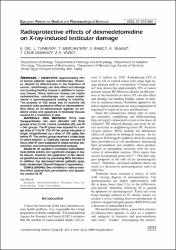Radioprotective effects of dexmedetomidine on X-ray-induced testicular damage

Göster/
Erişim
info:eu-repo/semantics/openAccessTarih
2023Yazar
Dil, EyüpTümkaya, Levent
Mercantepe, Tolga
Rakıcı, Sema Yılmaz
Yılmaz, Adnan
Samancı, Tuğba Çelik
Yazıcı, Zihni Açar
Üst veri
Tüm öğe kaydını gösterKünye
Dil, E., Tumkaya, L., Mercantepe, T., Rakici, S., Yilmaz, A., Celik Samanci, T., & Yazici, Z. A. (2023). Radioprotective effects of dexmedetomidine on X-ray-induced testicular damage. European review for medical and pharmacological sciences, 27(2), 673–680. https://doi.org/10.26355/eurrev_202301_31069Özet
OBJECTIVE: Approximately 70%
of cancer patients require radiotherapy. However, despite its effectiveness in the treatment of
cancer, radiotherapy can also affect and damage
surrounding healthy tissues in addition to tumorous tissues. Since testicular tissues are highly
radiosensitive, radiotherapy can cause impairments in spermatogenesis leading to infertility.
The purpose of this study was to examine the
potential radio-protective effect of dexmedetomidine (Dex), an α2-adrenoceptor agonist, on oxidative stress and apoptosis in testicular tissues
caused by x-irradiation in rats.
MATERIALS AND METHODS: Thirty male
Sprague-Dawley rats were allocated into three
groups of ten (n=10): control, irradiation (IR), and IR
+ Dex groups. The IR group was exposed to a single dose of 2 Gy IR. The IR+Dex group was given a
single intraperitoneal (i.p.) dose of 100 µg/kg Dex
before IR. The control group received a single dose
of saline solution i.p. Testicular tissues removed 24
hours after IR were subjected to histochemical, biochemical, and immunohistochemical analysis.
RESULTS: IR resulted in increased malondialdehyde (MDA) activity and significant changes in testis tissues. However, the application of Dex elevated glutathione levels by preventing MDA formation.
In addition, Dex decreased tubular epithelial apoptosis via elevated Cleaved Caspase-3 expressions.
CONCLUSIONS: Dex exhibited a radio-protective effect against lipid peroxidation and apoptosis caused by IR.

















